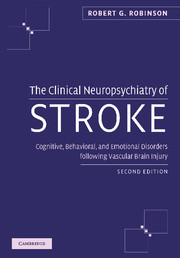 The Clinical Neuropsychiatry of Stroke
The Clinical Neuropsychiatry of Stroke Book contents
- Frontmatter
- Contents
- Preface
- Part I Introduction
- 1 Recent trends in the epidemiology of stroke
- 2 Historical perspective
- 3 Brain organization and cerebral basis of emotion
- 4 Vascular anatomy and classification of stroke
- Part II Poststroke depression
- Part III Poststroke mania
- Part IV Poststroke anxiety disorders
- Part V Other poststroke disorders
- Index
1 - Recent trends in the epidemiology of stroke
from Part I - Introduction
Published online by Cambridge University Press: 01 October 2009
- Frontmatter
- Contents
- Preface
- Part I Introduction
- 1 Recent trends in the epidemiology of stroke
- 2 Historical perspective
- 3 Brain organization and cerebral basis of emotion
- 4 Vascular anatomy and classification of stroke
- Part II Poststroke depression
- Part III Poststroke mania
- Part IV Poststroke anxiety disorders
- Part V Other poststroke disorders
- Index
Summary
Stroke like other illnesses has a dynamic evolution as a result of increasing knowledge and availability of healthcare around the world. In the 1970s, much of the epidemiological literature documented the declining incidence of stroke from 1945 to 1974. The annual incidence of stroke for both men and women between 1945 and 1949 was 190 per 100,000 population in the Rochester, Minnesota area. In 1970–1974, the rate had dropped to 104 per 100,000 population. During this time, the rates had dropped in all age categories, but were particularly dramatic in the very old. For example, in 1964, the average annual rates for those 55 to 59 years and those 80 years or older were 209 and 2932 per 100,000 persons respectively or a ratio of 1:14. By 1974, the average annual rates for these age groups had declined to 205 and 1287 per 100,000 or a ratio of 1:6. For both men and women the annual incidence rates increased with increasing age from 55 through 80 (Garraway et al. 1979).
In Japan, the incidence of cerebral infarction declined by 34% and that of cerebral hemorrhage by 29% between the periods 1961–1966 and 1972–1976 (Ueda et al. 1981). This decline was thought to be primarily the result of improved control of hypertension.
- Type
- Chapter
- Information
- The Clinical Neuropsychiatry of StrokeCognitive, Behavioral and Emotional Disorders following Vascular Brain Injury, pp. 3 - 8Publisher: Cambridge University PressPrint publication year: 2006


